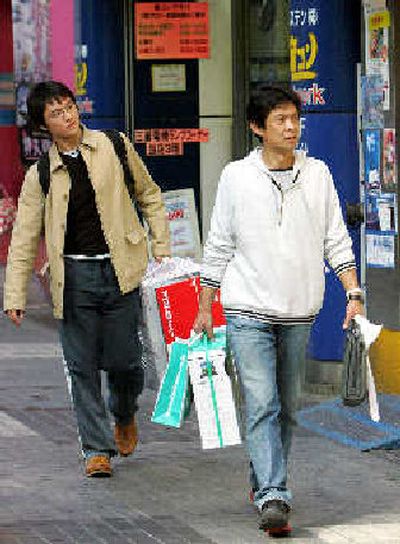Japan is shopping again

TOKYO — Kenshin Nakanishi peruses the wall of flat-screened televisions with price tags reaching the equivalent of $15,000 at a gleaming new nine-story electronics store as big as a city block.
Thanks to this year’s pay raise and a juicy 20 percent jump in his summer bonus, the 35-year-old can finally afford a new set and a comfy sofa to watch it from — to help fill out the pricey apartment he just moved into.
“A lot of people are spending now,” Nakanishi says. “I get the sense the economy is on the upswing.”
Long renowned for their assiduous savings, Japanese consumers like Nakanishi are at long last opening their wallets. And the spending habits are a big reason for optimism that Japan’s economic rebound from 15 years in the doldrums is not a false dawn, like the brief upticks that have sparked hopes every few years.
Domestic consumption is becoming a growth engine for the world’s second-largest economy and may even help reduce the ballooning U.S. trade deficit. Coupled with falling unemployment, steady exports and a rallying stock market, Japan’s long-maligned economy seems finally poised to turn the corner.
“It’s the real thing,” said Stefan Worrall, a Tokyo-based economist at Credit Suisse First Boston. “You have the foundations for quite a long, sustainable domestic recovery. It’s going be pretty hard to reverse.”
When Japan’s stock and real estate bubbles burst in the early 1990s, the country slumped from economic role model to cautionary tale on the excesses of protectionism, loose lending and state-championed industries.
Growth flatlined, corporate earnings plunged and banks were swamped by bad debt. Salaries shrank, while unemployment hit historic highs. The quagmire dragged on for more than a decade as Japan opted for gradual reform instead of the “shock therapy” urged by international investors.
But years of corporate belt-tightening, layoffs, bad-loan write-offs, deregulation and cuts in pork-barrel spending have helped whip the economy in shape, economists say.
Annual economic growth was recently upgraded to 3.3 percent in the April-June quarter from an earlier estimate of 1.1 percent. Land prices are rising for the first time in 15 years.
Unemployment dropped to 4.1 percent in June, its lowest since 1998, and the Tokyo Stock Exchange’s benchmark index has rocketed to four-year highs. Meanwhile, Prime Minister Junichiro Koizumi is fresh off a landslide election victory and promising sweeping financial reforms to further invigorate the economy.
The biggest difference between now and the 1990s is that earlier economic upturns were driven by exports, while private consumption — which accounts for just over half of the Japanese economy — was bottoming out as troubled companies cut jobs and slashed wages.
Now trimmed-down Japanese firms are raising their summer and winter bonuses and replacing part-time workers with better paid full-time ones.
“The major factor is the consumer looks more resilient,” said Glenn B. Maquire, chief economist at Societe Generale in Hong Kong.
Looming risks remain, however.
Japan imports nearly all of its oil, and businesses fretted when crude prices peaked at $70.85 a barrel on Aug. 30. Prices have eased but are still double those of 2003. Also, a possible slowdown in the U.S. economy could cool demand for Japan’s major exports — cars and electronics.